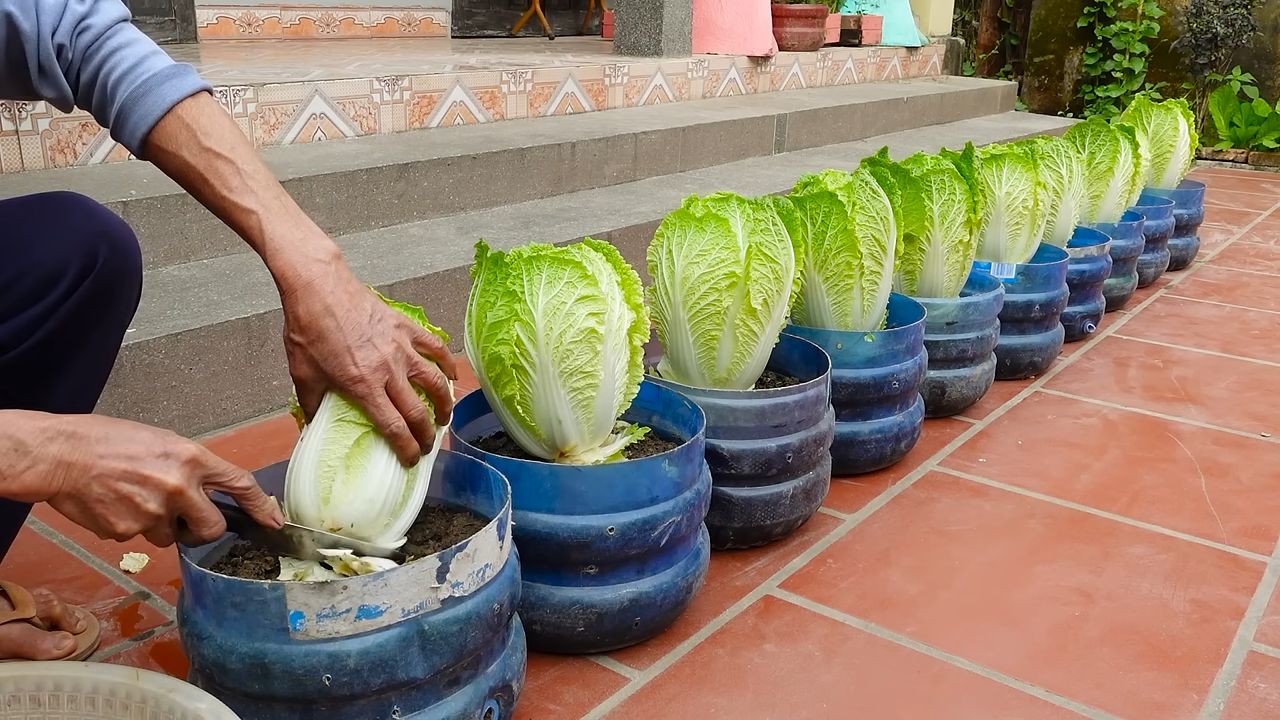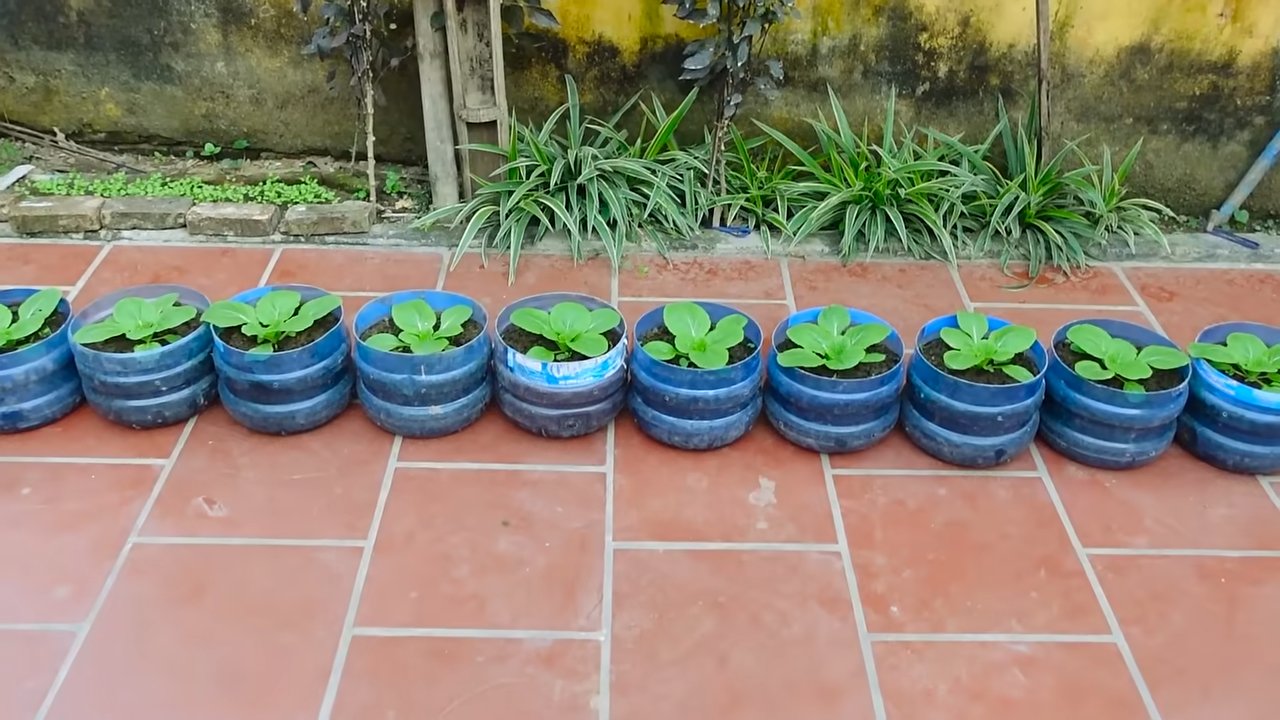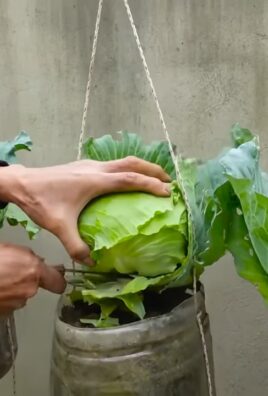Grow Chinese Cabbage at Home: Imagine stepping into your backyard and harvesting crisp, delicious Chinese cabbage, ready to be stir-fried, added to a vibrant salad, or fermented into tangy kimchi. Sounds dreamy, right? Well, it doesn’t have to be just a dream! This DIY guide is your passport to cultivating this versatile vegetable right in your own garden, no matter how small your space might be.
For centuries, Chinese cabbage has been a staple in Asian cuisine, revered not only for its flavor but also for its nutritional benefits. From ancient farming practices to modern-day gardens, this leafy green has nourished families and communities. But you don’t need to be an expert gardener to enjoy the fruits (or rather, vegetables!) of your labor.
In today’s world, knowing where your food comes from is more important than ever. Growing your own Chinese cabbage allows you to control what goes into your food, ensuring it’s free from harmful pesticides and packed with freshness. Plus, there’s nothing quite like the satisfaction of nurturing a plant from seed to harvest. So, let’s dive in and discover the simple yet effective tricks and hacks that will help you successfully grow Chinese cabbage at home, even if you’re a complete beginner. I’m excited to share these tips with you!

Growing Chinese Cabbage Yourself: Your DIY Guide for a Rich Harvest
Hey garden friends! Do you want to harvest fresh, crisp Chinese cabbage directly from your own garden? I’ll show you how! Chinese cabbage is not only super tasty and versatile in the kitchen, but also relatively easy to grow, even if you’re not a professional gardener. Let’s get started!
What You Need: The Preparation
Before we start planting, we need to make sure we have everything necessary on hand. Here is a list of the things you will need:
- Chinese cabbage seeds: Choose a variety that is suitable for your climate. There are early and late varieties, so find out which one best suits your region.
- Seed starting mix: For starting seeds indoors or in a greenhouse.
- Garden soil: Well-drained, humus-rich soil is ideal for Chinese cabbage.
- Compost or organic fertilizer: To enrich the soil with nutrients.
- Seed pots or trays: For starting seeds.
- Watering can or garden hose: For watering.
- Garden tools: Spade, rake, trowel.
- Slug pellets (optional): Unfortunately, Chinese cabbage is very popular with slugs.
- Fleece or net (optional): To protect against pests like cabbage white butterflies.
Sowing: How to Start Your Chinese Cabbage Seedlings
Chinese cabbage can either be sown directly into the garden bed or started indoors. I recommend starting them indoors, as this gives you control over germination and better protects the young plants from pests.
- Prepare the seed pots: Fill the seed pots or trays with seed starting mix. Lightly press the soil down.
- Sow the seeds: Place 2-3 seeds in each pot. Cover the seeds with a thin layer of soil (approx. 0.5 cm / 0.2 inches).
- Watering: Gently moisten the soil with a spray bottle or watering can. The soil should be damp, but not wet.
- Location: Place the seed pots in a bright and warm place (approx. 18-20°C / 64-68°F). A greenhouse or a windowsill is ideal.
- Moisture: Keep the soil evenly moist. Avoid waterlogging.
- Germination: The seeds usually germinate within 5-10 days.
- Pricking out: As soon as the seedlings have 2-3 true leaves (in addition to the seed leaves), you can prick them out. This means you transplant the strongest seedlings into larger pots so they have more space to grow. Choose the strongest seedling per pot and carefully remove the others.
Planting Out: Into the Garden Bed!
After about 4-6 weeks, when the seedlings are strong enough (approx. 10-15 cm / 4-6 inches high), they can be planted out into the garden bed.
- Prepare the bed: Loosen the soil thoroughly and remove weeds. Work compost or organic fertilizer into the soil to enrich it with nutrients.
- Plant spacing: Chinese cabbage needs enough space to grow. Maintain a planting distance of about 30-40 cm (12-16 inches) between plants and 50-60 cm (20-24 inches) between rows.
- Planting holes: Dig planting holes that are slightly larger than the root balls of the seedlings.
- Planting the seedlings: Carefully place the seedlings in the planting holes. Make sure not to damage the root balls.
- Filling the planting holes: Fill the planting holes with soil and press it down lightly.
- Watering: Water the seedlings thoroughly after planting.
Care: Keeping Your Chinese Cabbage Healthy and Strong
Chinese cabbage is relatively low-maintenance, but you should keep a few things in mind to achieve a rich harvest.
- Watering: Chinese cabbage needs regular water, especially during dry periods. Make sure the soil is always slightly moist. However, avoid waterlogging.
- Fertilizing: Fertilize the Chinese cabbage regularly with organic fertilizer or compost. An additional application of a nitrogen-rich fertilizer can promote growth.
- Weed control: Keep the bed free of weeds, as weeds rob the Chinese cabbage of nutrients and water.
- Pest control: Unfortunately, Chinese cabbage is susceptible to pests such as slugs, cabbage white butterflies, and flea beetles.
- Slugs: Sprinkle slug pellets around the plants or regularly collect the slugs by hand.
- Cabbage whites: Protect the plants from the cabbage white butterflies with a fleece or net. You can also pick off the caterpillars.
- Flea beetles: Keep the soil moist and loosen it regularly. You can also spray with a mixture of water and neem oil.
- Diseases: Chinese cabbage can be affected by various diseases, such as downy mildew or clubroot.
- Downy mildew: Ensure good air circulation and avoid waterlogging. Remove affected leaves.
- Clubroot: Do not plant Chinese cabbage in areas that have already been affected by clubroot. Ensure good soil health and a neutral pH value.
The Harvest: Finally, Time to Harvest!
Depending on the variety and sowing time, the Chinese cabbage is ready for harvest after about 8-12 weeks.
- When to harvest: Chinese cabbage is ready for harvest when the head feels firm and the leaves are closed.
- How to harvest: Cut the Chinese cabbage just above the ground with a sharp knife or garden shears.
- Storage: Chinese cabbage can be stored in the refrigerator for a few days. It is best to wrap it in a damp cloth.
Extra Tips for a Successful Chinese Cabbage Harvest
- Practice crop rotation: Do not plant Chinese cabbage in the same area every year. Rotate your crops to prevent diseases and pests.
- Companion planting: Chinese cabbage gets along well with other vegetables such as lettuce, spinach, radishes, or dill.
- Variety selection: Choose a variety that is suitable for your climate and soil conditions.
- Soil analysis: A soil analysis can help you determine the pH and nutrient content of your soil and improve it accordingly.
- Observation: Regularly observe your plants for pests and diseases. The earlier you identify problems, the better you can combat them.
Avoid Common Mistakes
Neglecting pest control: Chinese cabbage is susceptible to pests. Regular monitoring and control are important.
Planting too closely: Chinese cabbage needs enough space to grow. Planting too closely leads to smaller heads and increases the risk of disease.
Too little water: Chinese cabbage needs regular water, especially during dry periods.
Too little fertilizer: Chinese cabbage is a heavy feeder and needs sufficient nutrients.

Conclusion
So, there you have it! Growing Chinese cabbage at home is not only achievable, but it’s also incredibly rewarding. From the crisp, fresh taste that surpasses anything you can buy in a store, to the satisfaction of nurturing your own food, this DIY project is a must-try for any home gardener, regardless of experience level. Forget those wilted, overpriced heads at the supermarket; imagine stepping into your garden and harvesting vibrant, healthy Chinese cabbage whenever you need it.
This isn’t just about saving money; it’s about connecting with your food source, reducing your environmental impact, and enjoying the unparalleled flavor of homegrown produce. Plus, the process itself is therapeutic and educational, offering a fantastic opportunity to learn about plant life cycles and sustainable gardening practices.
But the best part? The possibilities are endless! Experiment with different varieties of Chinese cabbage to discover your favorites. Try growing them in containers if you have limited space, or consider succession planting to ensure a continuous harvest throughout the growing season. You can even explore companion planting techniques to deter pests and improve the overall health of your garden.
Don’t be afraid to get creative! Perhaps you’ll discover that your Chinese cabbage thrives in a slightly shadier spot than recommended, or that a particular type of fertilizer works wonders for its growth. The beauty of DIY gardening is the freedom to adapt and personalize the process to suit your specific environment and preferences.
We wholeheartedly encourage you to embark on this exciting gardening adventure. Start small, be patient, and don’t be discouraged by occasional setbacks. Every gardener faces challenges, but the rewards of growing your own food are well worth the effort.
And most importantly, we want to hear about your experiences! Share your tips, tricks, and triumphs in the comments below. Let us know which varieties you’ve tried, what challenges you’ve overcome, and what delicious dishes you’ve created with your homegrown Chinese cabbage. Your insights could inspire other readers to take the plunge and discover the joys of DIY gardening for themselves. Let’s build a community of passionate home gardeners, sharing our knowledge and supporting each other along the way. So, grab your seeds, get your hands dirty, and start growing Chinese cabbage at home today! You won’t regret it.
Frequently Asked Questions (FAQs)
What are the best varieties of Chinese cabbage to grow at home?
There are several excellent varieties of Chinese cabbage suitable for home gardens. ‘Napa’ cabbage is perhaps the most well-known, with its tightly packed, oblong head and mild flavor. ‘Michihili’ is another popular choice, known for its tall, cylindrical shape and slightly more pungent taste. For smaller gardens or container growing, consider ‘Baby Choi’ or other bok choy varieties, which offer a similar flavor profile but in a more compact form. Ultimately, the best variety for you will depend on your personal preferences and growing conditions. Experiment with a few different types to see which ones thrive in your garden and appeal to your taste buds.
How much sunlight does Chinese cabbage need?
Chinese cabbage generally requires at least 5-6 hours of direct sunlight per day to thrive. However, in hotter climates, it can benefit from some afternoon shade to prevent bolting (premature flowering). If you’re growing Chinese cabbage indoors, supplement with grow lights to ensure adequate light exposure. Observe your plants closely and adjust their position as needed to optimize their access to sunlight.
What kind of soil is best for growing Chinese cabbage?
Chinese cabbage prefers well-drained, fertile soil that is rich in organic matter. Amend your soil with compost or well-rotted manure before planting to improve its structure and nutrient content. The ideal soil pH for Chinese cabbage is between 6.0 and 7.5. Conduct a soil test to determine your soil’s pH and nutrient levels, and adjust accordingly.
How often should I water my Chinese cabbage plants?
Chinese cabbage needs consistent moisture to grow properly. Water deeply and regularly, especially during dry periods. Aim to keep the soil consistently moist but not waterlogged. Mulching around your plants can help to retain moisture and suppress weeds. Check the soil moisture regularly by sticking your finger into the soil a few inches deep. If the soil feels dry to the touch, it’s time to water.
What are some common pests and diseases that affect Chinese cabbage?
Chinese cabbage can be susceptible to various pests and diseases, including aphids, cabbage worms, flea beetles, and clubroot. Regularly inspect your plants for signs of infestation or disease. Use organic pest control methods, such as insecticidal soap or neem oil, to manage pests. Practice crop rotation and ensure good drainage to prevent diseases. Consider using row covers to protect your plants from pests.
How do I know when my Chinese cabbage is ready to harvest?
Chinese cabbage is typically ready to harvest when the head is firm and tightly packed. The exact time will vary depending on the variety and growing conditions, but generally, it takes about 60-80 days from planting to harvest. Gently squeeze the head to check for firmness. If it feels solid and compact, it’s likely ready to pick. You can also harvest individual leaves as needed for salads or stir-fries.
Can I grow Chinese cabbage in containers?
Yes, you can successfully grow Chinese cabbage in containers, especially smaller varieties like ‘Baby Choi’ or bok choy. Choose a container that is at least 12 inches deep and wide to provide adequate space for the roots to grow. Use a well-draining potting mix and ensure that the container has drainage holes. Water regularly and fertilize as needed.
How can I prevent my Chinese cabbage from bolting?
Bolting (premature flowering) can occur when Chinese cabbage is exposed to stress, such as high temperatures or inconsistent watering. To prevent bolting, choose bolt-resistant varieties, plant at the appropriate time of year (usually spring or fall), provide adequate shade during hot weather, and water consistently.
What are some good companion plants for Chinese cabbage?
Companion planting can help to deter pests, improve soil health, and enhance the growth of Chinese cabbage. Good companion plants include dill, chamomile, rosemary, and thyme. Avoid planting Chinese cabbage near members of the brassica family, such as broccoli or cauliflower, as they can attract similar pests and diseases.
How do I store harvested Chinese cabbage?
To store harvested Chinese cabbage, wrap it loosely in a damp paper towel and place it in a plastic bag in the refrigerator. It should keep for up to a week. You can also blanch and freeze Chinese cabbage for longer-term storage.




Leave a Comment